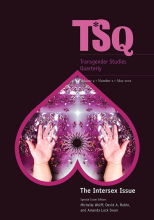Envisioning African Intersex
Amanda Lock Swarr received a 2022 Second Book Fellowship from the Simpson Center for the Humanities for her book Envisioning African Intersex: Challenging Colonial and Racist Legacies in South African Medicine, forthcoming from Duke University Press in March 2023. This fellowship provides funding for associate professors to give intensive attention to second book manuscripts that are near completion.
Envisioning African Intersex explores how histories of colonialism and scientific racism are integral to contemporary intersex medicine, focusing on African intersex activists’ challenges to dominant representations and violence. The book centers the insights of the first openly intersex activist in Africa and a pioneer of intersex legislation. It explores contemporary social media activism challenging the spectacularization of South African track star Caster Semenya. And it elucidates contemporary African intersex activists’ strategies for inciting policy and protocol changes. In sum, Dr. Swarr’s book urges a reconceptualization of gender policing that extends into realms including medicine, law, and sport policy.
The Intersex Issue of TSQ
Dr. Swarr also co-edited the May 2022 special issue of TSQ: Transgender Studies Quarterly, together with Michelle Wolff and David A. Rubin. The title of The Intersex Issue “plays on the issue making of intersexuality by medical providers, parents, academicians, and society that has harmful and sometimes deadly consequences.” Wolff, Rubin, and Swarr, as scholars working in both intersex studies and trans* studies, consider overlapping analytic and methodological tools and theoretical and political insights. In their introduction, they state, “While intersex studies and trans* studies may seem like “natural allies,” our effort in curating this special issue was to create a space to critically consider the differences and tensions as well as the commonalities and resonances between these fields.”
